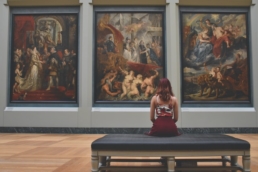LA GESTIONE DEI BENI CULTURALI AI TEMPI DEL COVID-19 – Parte IV
MANAGEMENT OF CULTURAL HERITAGE IN COVID-19 TIMES
by Azzurra Baggieri
After having interviewed the anthropologist Gaspare Baggieri on the effects of COVID-19 on Italian State Museums (link) and the art historian Rossana Vitiello on how her way of working has changed (link), we had the opportunity to ask Jacopo Gnisci, a Fellow at the University of Oxford, some questions about the impact of the closure of museums, the measures adopted by the English Government to protect their collections (guaranteeing employees stay at home), and, lastly, the destiny of international exhibitions in this time of crisis.
1) Our communities are living a very difficult period, and even the heritage sector is facing problems because of the health emergency. Many museums across the world (large and small), which will remain closed until the end of this crisis, have decided to make their collections accessible through virtual visits. In your opinion does the way of experiencing art change with the virtual visit? What are the main differences between a guided tour and a virtual visit?
When we engage art, we become entangled, through our senses, in a sort of internal dialogue between our perspectives and emotions, on the one side, and the object and the context of its display, on the other. Our response to this encounter is affected by a myriad of factors, of which we may or may not be aware, that range from our state of mind on that particular day to the noise made by the people around us, in the case of a museum visit. When we visit a virtual museum our experience of objects inevitably changes because they are flattened, their scale is distorted by the size of our screen, and we perceive them in the context of our own home, surrounded by other objects, sounds, and smells that are more familiar to us. A virtual tour of a museum is neither better nor worse than a walk across its the corridors, it is simply a different experience.
2) In Italy specific rules have been adopted for National Museums in order to protect their collections and allow their employees to stay at home. Has the English Government adopted similar measures? What could be the impact of these special laws?
Museums face several challenges because of the Covid-19 lockdown. Criminals may try to take advantage of the fact that the number of security personnel has been decreased. Last week, for instance, a Van Gogh was stolen from the Singer Laren in the Netherlands. Conservation could also represent an issue if the lock-down continues for an extended period. In any case, according to the latest guidance published by The Arts Council England, museum staff can travel to work if their attendance is necessary for the security or preservation of the cultural objects, and if their work cannot be carried out from home, as long as they follow the Government’s general advice on Covid-19 and maintain social distancing.
3) What is the destiny of international exhibitions in this period? What has been decided in order to stop the displacement of art? How will international collaborations be affected?
In many cases, when it is possible, funding bodies and institutions are simply freezing their calendar and postponing outreach events and activities which involve public gatherings. However, this will often not be possible due to scheduling conflicts or to the impossibility of renewing existing agreements for legal, logistical, and financial reasons; in fact, there has already been a string of cancellations. Sadly, this is a lose-lose situation, the museums will face a huge revenue drop, the sponsors will not get a return in terms of visibility, the curators will feel like their work has not reached others, the general public will not get to experience the display, and so on. However, small businesses, such as art galleries with high rents, as well as furloughed staff will probably be the most severely affected by the current situation. In the UK some galleries have already asked the government to support cultural institutions through a programme similar to the Franklin D Roosevelt’s Public Works of Art Project (PWAP) which employed artists during the Great Depression and helped to advance the career of several of the major figures of the Abstract Expressionist movement.
picture by Una Laurencic


